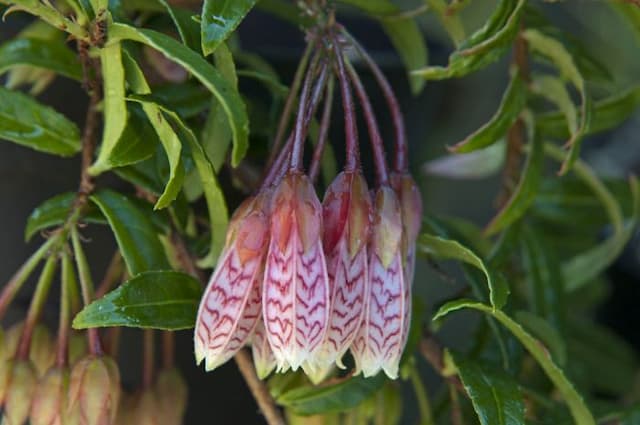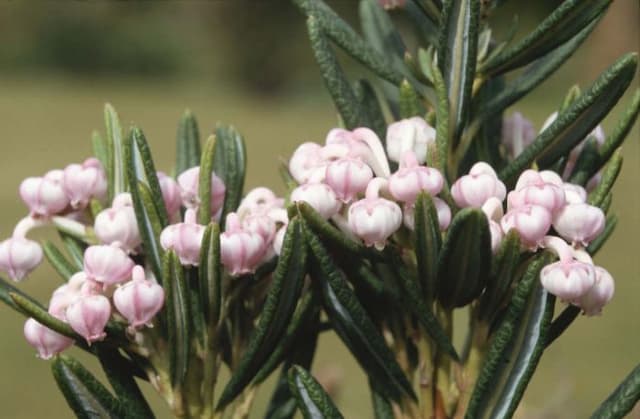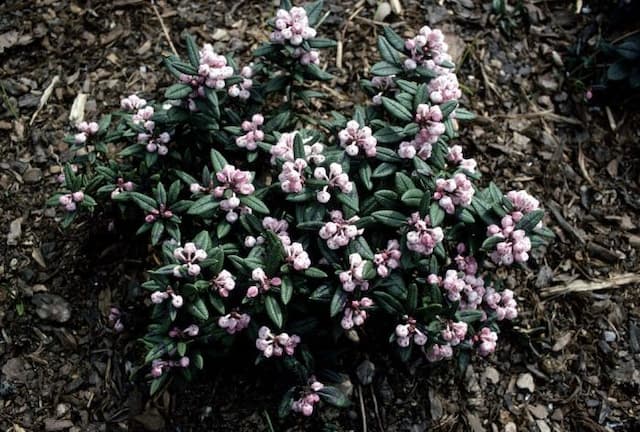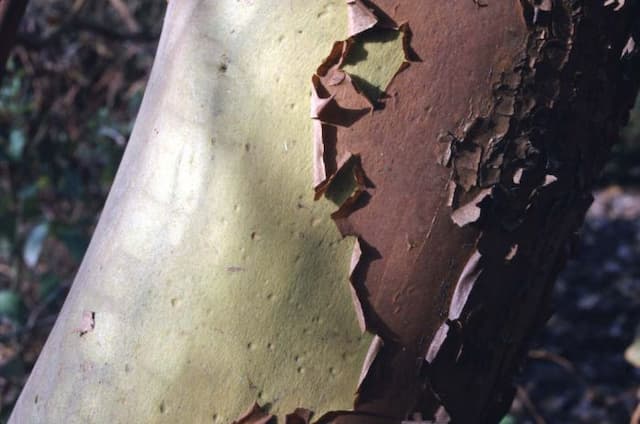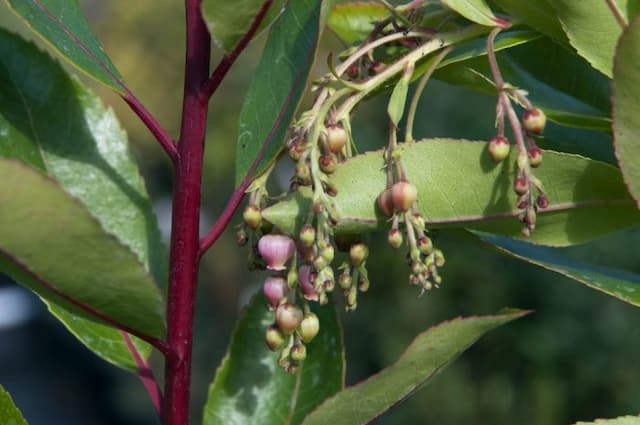Irish Heath Erica × stuartii 'Irish Orange'

ABOUT
The plant known as 'Irish Orange' typically showcases a vibrant display of color with a cascade of delicate, bell-shaped flowers. The flowers are a striking orange hue, a color that is sure to stand out in any garden setting. The foliage is dense and bushy, presenting a lush backdrop of small, needle-like leaves that may have a green to dark green tone. The leaves are arranged closely together, creating a fine, textured look due to their small size and tight growth habit. Together, the vivid orange flowers and the verdant leaves offer a contrast that is both bold and eye-catching. With their beautiful coloration and dense foliage, these plants are often used to bring a splash of brightness and to add visual interest to garden landscapes. They may attract various pollinators, adding a dynamic element to their surroundings. Overall, 'Irish Orange' has a picturesque quality and is valued for its ornamental beauty, especially during its blooming period when it is awash with radiant orange flowers.
About this plant
 Names
NamesFamily
Ericaceae
Synonyms
Irish Heath, Irish Orange Heath
Common names
Erica × stuartii 'Irish Orange'.
 Toxicity
ToxicityTo humans
The Irish Heather (Erica × stuartii 'Irish Orange') is not commonly listed as a toxic plant to humans. There is little to no evidence of severe toxicity in humans resulting from contact with or ingestion of this plant. However, as with many plants, individual allergies or sensitivities could occur, which might result in mild irritation or discomfort, but this is not common.
To pets
The Irish Heather is also not commonly known to be toxic to pets. There is no significant evidence to suggest that the plant poses a severe risk if ingested by animals such as dogs or cats. However, it's always prudent to keep an eye on your pets and prevent them from eating plants since individual animals might have different reactions or sensitivities to various plant species. If you suspect your pet has ingested a potentially toxic plant and is showing symptoms like vomiting, diarrhea, or unusual behavior, consult your veterinarian.
 Characteristics
CharacteristicsLife cycle
Perennials
Foliage type
Evergreen
Color of leaves
Green
Flower color
Orange
Height
1-2 feet (30-60 cm)
Spread
1-2 feet (30-60 cm)
Plant type
Shrub
Hardiness zones
7
Native area
Europe
Benefits
 General Benefits
General Benefits- Aesthetic Appeal - The 'Irish Orange' Heather adds vibrant color and texture to gardens with its orange flowers.
- Attracts Wildlife - It can attract bees, butterflies, and other pollinators, enhancing biodiversity.
- Low Maintenance - Typically easy to care for, requiring minimal pruning and upkeep once established.
- Drought Tolerance - Once established, it can withstand periods of low rainfall, suitable for xeriscaping.
- Evergreen - Retains its foliage year-round, providing continuous visual interest in a garden.
- Hardiness - It is often resistant to cold temperatures, suitable for a range of climates.
- Soil Adaptability - Can thrive in a variety of soil types, including poor quality soils, as long as they are well-drained.
- Ground Cover - Can be used to cover bare spots in the garden, reducing soil erosion and suppressing weeds.
- Versatility - Suitable for rock gardens, borders, and containers, offering various landscaping options.
- Compact Size - Its small size makes it ideal for use in spaces where other plants might be overwhelming.
 Medical Properties
Medical PropertiesThis plant is not used for medical purposes.
 Air-purifying Qualities
Air-purifying QualitiesThis plant is not specifically known for air purifying qualities.
 Other Uses
Other Uses- As a natural dye: The flowers and leaves of Irish Orange can be used to create a subtle, natural dye for textiles, offering an eco-friendly alternative to synthetic dyes.
- In photography: The vibrant colors of Irish Orange can provide an exceptional backdrop for macro or nature photography, enhancing the aesthetic of the image.
- As a crafting material: Dried flowers of Irish Orange can be incorporated into potpourri, wreaths, and other craft projects to add color and a light fragrance.
- As a teaching tool: Irish Orange can be used in educational settings to teach students about plant biology, hybridization, and garden design principles.
- In culinary presentation: While not edible, the bright blooms can be used as a garnish to embellish the plating of dishes in high-end culinary establishments.
- As a source of inspiration: Artists and designers can draw inspiration from the striking color and form of Irish Orange for various creative projects, including fashion design, illustration, and home decor.
- For miniature gardens: This compact plant is suitable for fairy gardens or miniature landscapes, adding a pop of color and scale-appropriate flora.
- In animal habitats: When planted in zoo or wildlife habitats, Irish Orange can add enrichment for the animals while providing a more natural and appealing environment for visitors.
- As a natural confetti: Dried petals of Irish Orange can be used as a biodegradable confetti alternative for celebrations and weddings.
- In aromatherapy crafts: Although not a traditional aromatherapy plant, the light scent of Irish Orange can be captured in homemade sachets and scented pillows for a subtle, calming effect.
Interesting Facts
 Feng Shui
Feng ShuiErica is not used in Feng Shui practice.
 Zodiac Sign Compitability
Zodiac Sign CompitabilityErica is not used in astrology practice.
 Plant Symbolism
Plant Symbolism- Endurance - Erica, commonly known as heather, is known for its hardy nature and ability to thrive in tough conditions, symbolizing one's ability to endure challenges.
- Protection - Heather has traditionally been associated with protective properties, possibly because in ancient times it was used for thatching roofs against the elements.
- Good Luck - In some cultures, heather represents good fortune, and carrying a sprig of it is believed to bring luck and guard against harm.
- Solitude - Heather sometimes grows in isolated patches on moorlands, symbolizing solitude and a love for one's own company.
- Admiration - With its small yet plentiful flowers, heather can represent admiration for the beauty and complexity that is found in the small details of life.
- Beauty - The vibrant color of Erica × stuartii 'Irish Orange' heather particularly adds an aspect of beauty and aesthetic pleasure to its symbolism.
 Water
WaterThe Irish Heath should be watered deeply, allowing the soil to become slightly dry between waterings. During active growth in spring and summer, it may need water about once a week, with approximately 1 gallon per plant each time, depending on the weather and soil drainage. In the fall and winter, reduce watering to every other week, ensuring the plant does not sit in waterlogged soil which can lead to root rot. Adjust the amount and frequency according to the plant's response and environmental conditions to maintain evenly moist soil.
 Light
LightIrish Heath thrives in full sunlight to partial shade. Choosing a spot that receives at least six hours of direct sunlight daily is optimal for its growth. If you live in a particularly hot climate, provide afternoon shade to protect the plant from scorching.
 Temperature
TemperatureIrish Heath prefers cool to moderate temperatures and will do best if the temperature is maintained between 60 and 75 degrees Fahrenheit. It can tolerate a minimum temperature of around 20 degrees Fahrenheit but should be protected from severe frosts. Avoid exposure to extreme heat above 80 degrees Fahrenheit.
 Pruning
PruningPrune Irish Heath to maintain shape and encourage bushy growth, typically after the blooming period in the late winter or early spring. Remove any dead or damaged branches, and thin out crowded areas to improve air circulation. It is also beneficial to trim back a third of the plant occasionally to rejuvenate its growth.
 Cleaning
CleaningAs needed
 Soil
SoilThe best soil mix for Irish Heath 'Irish Orange' is well-draining, rich in organic matter, with a low pH suitable for acid-loving plants, typically between pH 4.5 to 5.5. A mixture of peat, sand, and loamy soil usually works well.
 Repotting
RepottingIrish Heath 'Irish Orange' should be repotted every two to three years or when the plant becomes root-bound. Early spring, just before the new growth starts, is the ideal time for repotting.
 Humidity & Misting
Humidity & MistingIrish Heath 'Irish Orange' prefers moderate humidity levels, ranging from 40% to 60%. It thrives in an environment that has some humidity but does not require the high humidity levels often needed by tropical plants.
 Suitable locations
Suitable locationsIndoor
Place Irish Heath 'Irish Orange' in bright, indirect light and monitor watering.
Outdoor
Grow in partial shade, protect from harsh sun and winds, water as needed.
Hardiness zone
7-9 USDA
 Life cycle
Life cycleIrish Heather 'Irish Orange' begins its life cycle from seed germination, which usually occurs in a well-draining, acidic soil substrate rich in organic matter. Upon sprouting, the seedling enters a vegetative growth phase characterized by the development of its woody stem, needle-like leaves, and robust root system. As it matures, Irish Heather 'Irish Orange' reaches the flowering stage, producing numerous small, bell-shaped flowers with a distinctive orange hue that are attractive to bees and other pollinators during the summer and into fall. After pollination, the plant produces small capsules containing seeds, completing its reproductive cycle. Irish Heather 'Irish Orange' is an evergreen shrub, and so even after seed set, it continues vegetative growth, which allows it to maintain foliage throughout the year. This plant can live for several years, during which time it will repeat the flowering and seeding cycle annually.
 Propogation
PropogationPropogation time
Spring-Early Summer
Erica × stuartii 'Irish Orange', commonly known as the Irish Heath, can be propagated through semi-ripe cuttings during late summer. To do this, select healthy, non-flowering shoots from the current year's growth. Cuttings should be about 2 to 3 inches (5 to 7.5 centimeters) long and should include a small portion of the older wood at the base. This heel at the base often enhances rooting. Strip the lower foliage and dip the base into a rooting hormone powder or solution to encourage root growth. Plant the cuttings in a well-drained potting mix, ensuring the heel is buried, and place them in a shaded, sheltered area. Keep the potting mix moist but not waterlogged until roots develop, which may take several weeks. Covering with a plastic bag or placing them in a propagator can help maintain humidity.
